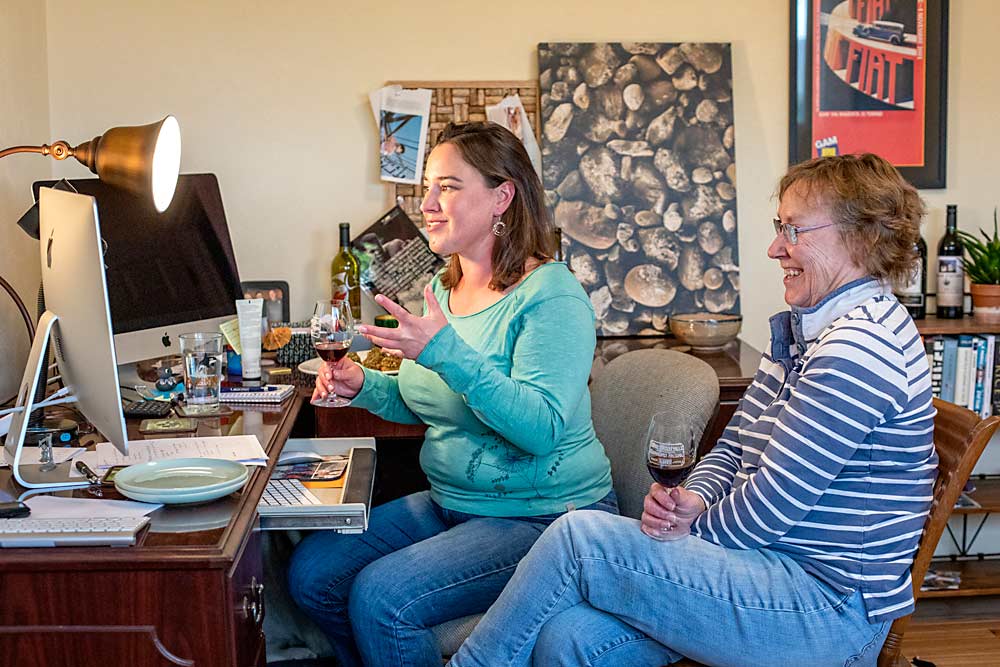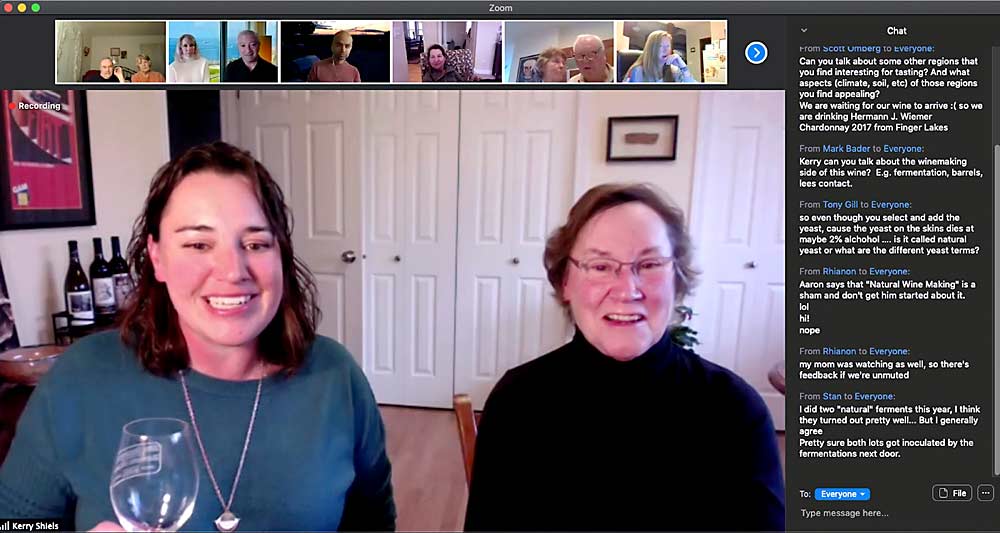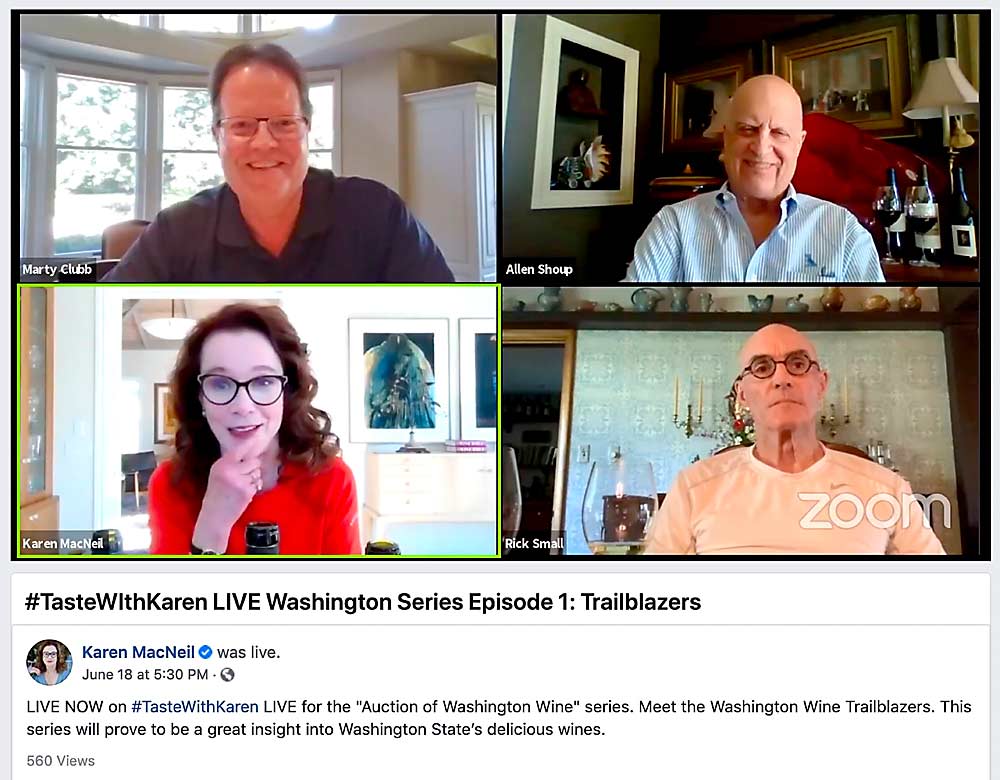
Growing a successful crop and producing award-winning wine typically comes with seasonal challenges, but this year the coronavirus took everyone by surprise when it forced states to shutter restaurants and tasting rooms. The stay-home orders spurred some wineries and venues to creatively find new ways to connect with consumers.
Days before the shutdown, Washington winemaker Kerry Shiels attended a workshop to learn how to produce live online group wine tastings. She planned to test-drive the idea with Côte Bonneville winery’s wine club.
“A couple of the wineries had done virtual tastings at that time,” Shiels said. But, “those tastings were more or less one-on-one.” What she wanted to do was recreate the social aspect of the tasting room, where people gather together to discuss featured wines: happy hour hosted by Zoom.
Shiels, like many others in the wine industry, turned to the group video conference software formerly known for business meetings that’s become ubiquitous during the pandemic, connecting family, friends, classmates and co-workers. With this technology, customers near and far can join in on expert-led tastings or vineyard tours. For wineries, the benefits of such virtual events may last far longer than the stay-home orders that prompted them.
“Engagement is our goal. We are getting new customers to the brand, but that is not the main goal for continuing,” Shiels said. “I think there’s a lot of potential, especially for businesses to talk with customers all over the country and have them very engaged.”

With her tasting room closed in March, she drew up an email asking her club members to tune in to a “Virtual Happy Hour.” That first conversation blossomed into a weekly social with attendees from all over the U.S. logging in to visit with her in her Sunnyside, Washington, office.
“Our happy hours have evolved since our first ones where we basically talked about the wines,” she said. “Now we feature food pairings and bring in speakers. It’s become something fun where most everyone returns each week.”
The wines set the stage for more complex topics and the online environment allowed Côte Bonneville fans to get to know each other.
Showing customers that personal touch is an important ingredient for online virtual gatherings, says Jamie Peha, executive director of the Auction of Washington Wines. “This virtual environment, particularly if they are interview-style or Zoom-style, can help create an emotional connection that you wouldn’t otherwise get,” Peha said.
In a traditional tasting room setting, a typical visitor may only get a few minutes with the winemaker or grower. “Customers aren’t going to get the time to hear the story behind the winery or the wine and all the different details that go into it,” she said.
Is there a future for wineries to continue online streaming when the pandemic is behind us? Peha and Shiels think virtual tastings will find a place in a winery’s communication tool kit even when tasting rooms open and events resume.
“Right now, customers are a captive audience and they want fun things to do,” Peha said. But in the future, “people are getting the hang of this and we may move into a hybrid-type environment where there are some in-person events and some virtual. This could continue to augment traditional outreach.” •
—by TJ Mullinax
Watch Kerry Shiels’ “Virtual Happy Hour” recordings on YouTube at https://www.youtube.com/playlist?list=PLFV8zk4oip8nCrm2RwCPCL7U_k-jvmInM
Tips for virtual tastings

Kerry Shiels, Jamie Peha and wine author Karen MacNeil, who is currently hosting the Auction of Washington Wines’ virtual tasting programs, offer advice for virtual events:
Include other wineries, experts and speakers. “You’re part of something bigger. Your wine will still shine, but you are part of a collaborative expression of the Washington wine industry,” Peha said. “So, you’re floating a bigger boat when you participate with other wineries.”
Pick the right platform. “If you have a loyal following of people who are buying your wines, then Zoom is a wonderful platform,” MacNeil said. “You can see people who have registered and provide offers and discounts on the wine in a more personal way. Also, people generally stay on longer during Zoom tastings. You are doing well if 50 percent of the audience stays on for 30 minutes or more.”
Start off with a script. “It’ll become more organic as you go,” Shiels said. “The fun thing with those first ones was that we didn’t know how to use the platform. Our customers didn’t know how to use the platform. As we learned together, we were able to make the programming more complex and engaging.”
Prepare your audience with digital methods for buying the featured wines beforehand and during the virtual event. “In our experience, one-third of attendees will buy the wine ahead of time, some will be intrigued and will eventually buy the wine, the rest will just listen and learn,” MacNeil said.
Get to know your audience, then bring in speakers who complement the group and what you want to share. “One of our speakers is one of my professors from UC Davis,” Shiels said, after a request from a consumer who wanted to learn more about the classification of grapevines. “So, here we are now, having a talk about grape breeding and genetics.”
Take time to learn, because the format isn’t going away anytime soon. “There’s more to learn using these tools,” Peha said. “With digital outreach you’ll really get to know and understand who your audience is, what their preferences are and what they enjoy. This information can help you better your business and marketing plans.”
—TJ Mullinax
Watch Karen MacNeil’s virtual tastings at https://auctionofwawines.org/karen-macneil-virtual-tastings






Leave A Comment